Effective Strategies to Deter Squirrels from Your Garden
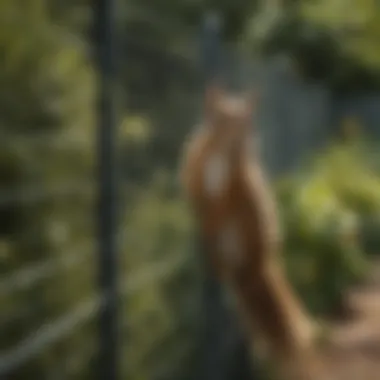
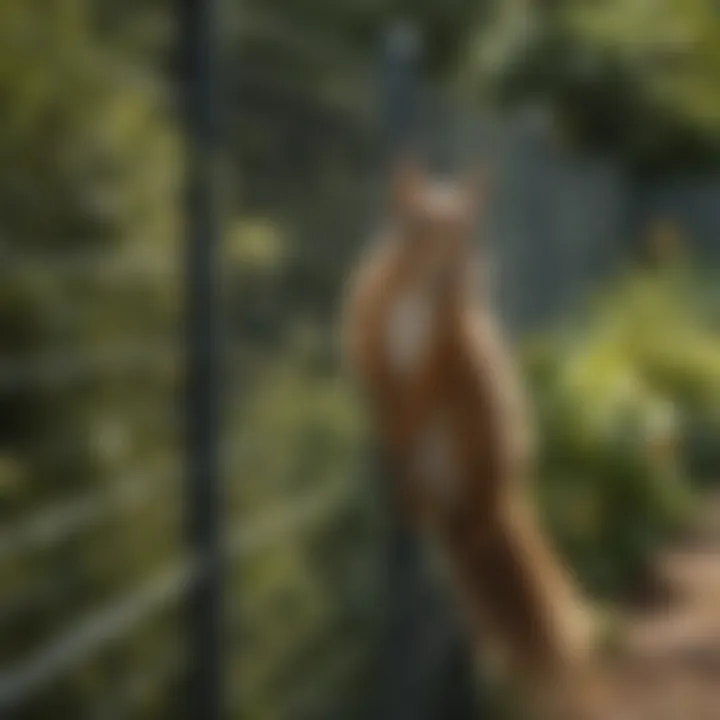
Intro
With nature showing its diverse side, many find themselves battling unexpected visitors in their gardens. Among these uninvited guests, squirrels top the list. While they may seem cute and harmless, the chaos they can wreak in well-tended gardens is no laughing matter. From munching on fruit to digging up newly planted seeds, these nimble critters can turn a peaceful patch of greenery into a battleground.
In this article, we'll delve deep into effective techniques to deter squirrels from your cherished garden. Our discussion will encompass a variety of methods—from using simple barriers to exploring natural repellents—so you can safeguard your plants without resorting to harm. Let’s take a closer look at both the behavior of squirrels and the impact they have on our gardening efforts.
By the end, you’ll be armed with practical knowledge and tools to defend your space against these furry foragers, all while maintaining a healthy and balanced ecosystem.
Understanding Squirrels
Before we can effectively deter squirrels, we first need to understand them. These little creatures are not merely pests; they play a significant part in the ecosystem. Their acrobatic antics and bushy tails make them a beloved sight for many, but this doesn't mean they can’t also be a frustration for those trying to cultivate a lovely garden.
Squirrels are resourceful feeders, often foraging for seeds, nuts, and fruits. A garden filled with such delights is an open invitation for them. Moreover, their nesting habits often lead to them raiding gardens in search for materials, resulting in further damage.
Here's where it gets tricky: squirrels are clever and can quickly learn how to navigate barriers designed to keep them out. It’s not just about the food they seek—it's also about adapting to the changes you make to protect your plants.
"Squirrels can adapt their behavior based on the limitations presented in their environment, demonstrating remarkable intelligence in their foraging strategies."
Practical Strategies to Deter Squirrels
Effective deterrence relies on a combination of methods. Let’s explore some tried-and-true tactics:
Physical Barriers
- Fencing: A solid fence can act as a first line of defense. Ensure it's at least four feet high, with the top angled outward to deter climbing.
- Row Covers: Lightweight fabric can provide a shield over young plants. Squirrels can't rip through yet can still allow sunlight and rain to reach the plants.
- Netting: Use bird or garden netting to cover fruit-bearing plants. It’s a visual deterrent and makes reaching your produce difficult.
Natural Repellents
Some scents can discourage squirrels. Consider:
- Cayenne Pepper: Sprinkling a little around the base of plants can send squirrels packing without harming them.
- Essential Oils: A few drops of peppermint or citrus oil on cotton balls scattered around the garden can act as a deterrent.
- Garlic Spray: Mix garlic powder with water to create a spray that can help keep the critters at bay.
Alternative Food Sources
You might think about leading them astray:
- Feeding Stations: If you have space, set up a dedicated feeding station with food they like, placing it away from your garden. This can divert their attention from your more precious plants.
"Providing squirrels a alternative food source may reduce their interest in raiding your garden, creating a win-win situation."
Noisy Deterrents
- Wind Chimes or Bells: Hang these around your garden to create an unsettling environment for squirrels. The sounds can make your garden less inviting.
- Motion-Activated Devices: Devices that make noise or spray water when they detect movement can give those squirrels a real fright.
Culmination
Taking the time to implement these strategies can likely lead to a more peaceful coexistence with the wildlife around you. Squirrels, while often seen as pests, are a part of the broader ecosystem. With a thoughtful approach, you can protect your plants and maintain your garden's integrity.
Understanding their behavior lays the groundwork for your strategies. The combination of physical barriers, natural repellents, and creative diversions holds promise for discouraged squirrels. So, roll up your sleeves and let’s keep those gardens thriving!
Understanding Squirrel Behavior
Understanding the behavior of squirrels is pivotal when it comes to creating effective strategies to deter them from your garden. Squirrels are not just cute little critters; they're crafty and resourceful creatures that can turn your hard work into a buffet. By grasping their habits, preferences, and seasonal behaviors, homeowners can devise targeted approaches to keep these furry intruders at bay.
Habitat and Feeding Preferences
Squirrels thrive in diverse environments, yet they have particular needs that dictate where they settle. These mammals prefer areas with ample trees, offering shelter and high vantage points. Your garden, especially if it is dotted with tall trees or thick shrubs, can appear as a buffet for them—a neat place with food galore.
Their feeding preferences focus on nuts, seeds, and fruits, but they're not picky eaters. Squirrels will munch on vegetables, bulbs, and even flowers if they are hungry enough. Knowing what attracts them helps homeowners choose plants wisely!
- Nuts and Seeds: Acorns, sunflower seeds, and walnuts are on top of the list.
- Fruits and Vegetables: Apples, tomatoes, and peppers can all be appealing.
- Ground Cover: A garden laden with mulch or compost creates a haven for foraging.
Squirrel Activity Patterns
Squirrel activity ramps up with the changing seasons. In spring and summer, they can appear energetically darting around, gathering food to stash away for winter. It’s a sight to see as they scurry up and down trees, but this is when they can also wreak havoc on gardens. Understanding their daily rhythm can be beneficial.
- Dawn and Dusk: Typically, squirrels are most active during these times. If you want to monitor their activity, setting up a simple observation project can give you insights on when they invade your garden.
- Nesting and Reproduction: Late winter to early spring marks their breeding season, and you might notice increased visits to your garden as they search for food to support their growing families.
- Weather Influence: Rainy days may scatter their activity, but they will make the most of sunny breaks.
Reasons for Garden Invasions
So, what drives squirrels to invade gardens? Their path to your beautiful landscaped yard often stems from specific motivations:
- Food Supply: If your garden features easy pickings, they will visit. Squirrels are opportunistic feeders that won’t shy away from what they consider an easy meal.
- Shelter and Nesting: Dense foliage can provide a safe haven. If your garden feels like home, your plants become their early-morning breakfast and late-night snack.
- Social Behavior: Squirrels can be social learners. If one squirrel finds your garden to be a good source of food, others may follow suit, banking on the experience.
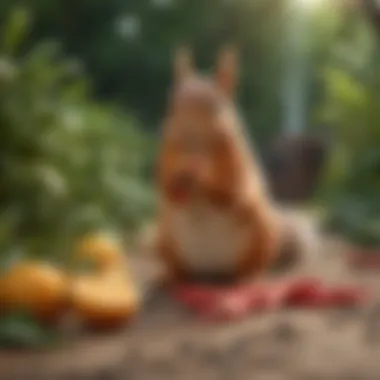
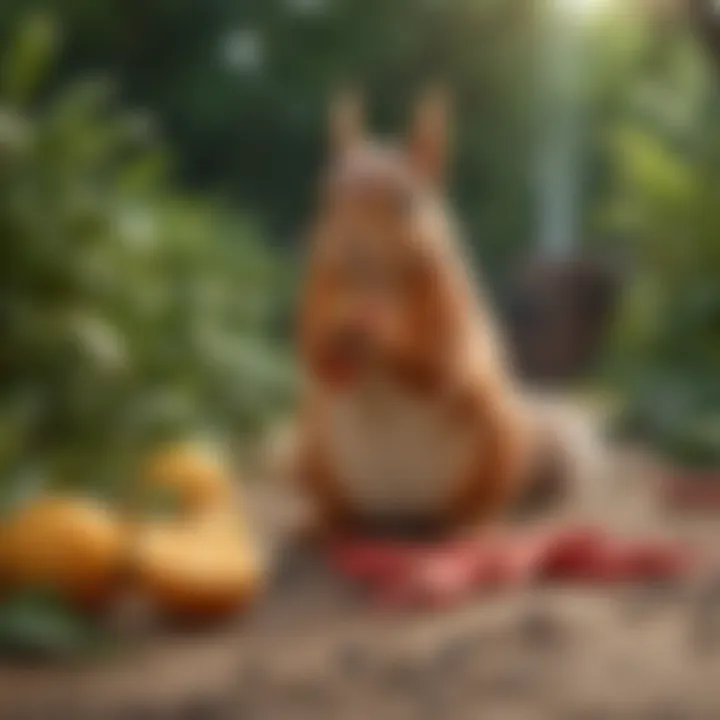
Understanding these aspects of squirrel behavior not only aids in deterrence but also fosters a more harmonious relationship between homeowners and their wildlife neighbors. With this foundation, the next steps can involve practical measures tailored to individual gardens, securing a fruitful area free of squirrel disturbances.
Identifying Signs of Squirrel Activity
Understanding how to spot signs of squirrel activity in your garden is crucial for any homeowner looking to protect their precious plants. These signs can give a clear indication of whether squirrels are present and how severe their impact might be. Knowing what to look for enables you to take early action before damage escalates. Moreover, being aware of squirrel behaviors can help tailor your deterrent strategies effectively.
Common Indicators of Damage
When it comes to spotting the signs that squirrels have been on a destructive spree, there are several specific indicators to be mindful of:
- Gnawed Plants: Look for chew marks on the stems, leaves, or even bulbs of your plants. Squirrels have sharp teeth that can create clean cuts or ragged edges on soft plant materials.
- Burrows and Nests: Squirrels are notorious for digging. If you see freshly disturbed soil or small holes around your garden, especially near root systems, it’s a red flag.
- Seed Disruption: If you've planted seeds recently, and they mysteriously disappear or get scattered, squirrels might have decided to have a snack. Often, you’ll find soil overturned or seeds scattered.
- Droppings: Dark, cylindrical droppings, similar to small dark jelly beans, can be a telltale sign of squirrel activity. Finding these, especially around your plants, indicates frequent visits.
"It's easier to tackle a problem when you know what you're dealing with. Spotting squirrel damage early can save you a lot of grief."
In addition to these indicators, observe your garden for any frayed cables or decorative items that might point to squirrels investigating your space.
Tracking Squirrel Presence
Keeping tabs on the squirrel population in your garden can significantly affect your gardening experience. Here are methods to track their presence:
- Observation: Spend some time just watching your garden at different times of the day. Squirrels tend to be most active during the early morning and late afternoon. This can provide insights into their movement patterns and feeding times.
- Set Up Cameras: Placing motion-activated cameras can be a useful endeavor. Not only does this technology allow you to monitor your plants when you’re not around, but it can also help catch the little critters in the act, making it clear if you need to step up your prevention efforts.
- Footprint Tracking: While this might sound a bit tedious, you can track their footprints in moist soil or even on your patio. Squirrel prints are distinctive with long toes and claws; if you notice small paw prints, then they’ve been roaming around and likely causing trouble.
- Damage Timing: Keep a diary of when you notice damage. Jotting down dates can help identify patterns or peak times when they invade your garden, guiding your protective strategies in the future.
Knowing these signs and tracking their activities effectively can empower homeowners to develop a proactive approach for maintaining their gardens. Keep an eye out, and with a bit of vigilance, you can keep those furry foes at bay!
Preventive Measures for Gardens
In the quest to keep squirrels at bay, understanding Preventive Measures for Gardens is key. The right tactics not only safeguard your plants but also give you peace of mind. Focusing on these methods means fewer headaches down the line, especially if you’ve invested time and effort into your garden.
Physical Barriers
Fencing Options
When it comes to fencing, it’s not just about height but also material. You might lean towards options like wire mesh or hardware cloth. These materials provide a sturdy barrier against those persistent critters. One of the standout features of using fencing is its ability to create a clear boundary. While a physical barrier might seem straightforward, it can be a considerable nuisance for squirrels, keeping them from rummaging through your prized vegetables.
The beauty of fencing lies in its durability. It doesn't only deter squirrels but also other pests. Yet, there’s a caveat; it’s not foolproof. Squirrels are known to be crafty, and if the fence has gaps or doesn’t extend underground, they might find a way to squeeze through. Therefore, while beneficial, a well-planned fencing approach is crucial to its effectiveness.
Netting Strategies
Netting, on the other hand, offers a more flexible approach. It’s often lightweight and easy to install, making it a favorite among gardeners. The unique feature of netting is that it can drape over plants without damaging them—this makes it a gentle yet effective deterrent. When squirrels come across these barriers, they usually back off rather than try to navigate through them, which minimizes both wear and tear on your plants.
However, considerations arise when using netting. Wind can sometimes displace it, so checking regularly is smart. Plus, if you’re not careful, the net can entangle unsuspecting birds or other wildlife. Therefore, while netting is a practical option, it’s essential to monitor its condition.
Plant Selection
Squirrel-Resistant Plants
Opting for Squirrel-Resistant Plants is a proactive strategy worth considering. Some plants, like marigolds or daffodils, are often unappealing for squirrels due to their taste or smell. This selectiveness allows for a natural deterrent, as these plants are less likely to draw the critters in. Choosing such species introduces a level of strategy to your gardening efforts.
These plants often thrive alongside more appealing species, creating a shield of sorts around them. Their resistance can foster a more fruitful garden environment. However, one must note that while they deter squirrels, they may not repel all garden pests.
Avoiding Attractive Species
Similarly, the strategy of Avoiding Attractive Species focuses on being mindful of what you plant. Squirrels are particularly fond of soft fruits like strawberries or tender plants such as sunflowers. If you want to keep these critters away, it’s wise to steer clear of those plants in your garden composition. This not only prevents unwanted visitors but also encourages a garden ecosystem that is more balanced and sustainable.
The advantage here is straightforward: planting less attractive species means fewer squirrel sightings. But as you make these choices, keep in mind local wildlife dynamics.
Organizing a garden means understanding its inhabitants. Being selective about what grows can either attract or repel those pesky squirrels.
Crafting a successful gardening environment relies on these preventive measures, integrating both physical barriers and smart plant choices. This way, you create a harmonious platform for your plants to flourish while keeping the squirrels at bay.
Repellent Techniques
In the quest to keep squirrels at bay, employing repellent techniques can be an effective line of defense. These methods center around disturbing the squirrels’ comfort in your garden and creating an environment that they would rather avoid. Repellents are important not just for protection of your plants but also for maintaining a suitable ecosystem that respects wildlife. While many homeowners wander down the path of traps and other invasive measures, understanding repellent strategies can lead to a more sustainable approach.
Natural Repellents
Natural repellents harness elements of nature to fend off squirrels. This avenue offers the benefit of being less harmful to the environment while catering to the preferences of those who lean toward organic solutions.
Essential Oils
Essential oils emerge as potent agents in squirrel deterrence, engaging the unique scents that these critters find off-putting. For instance, peppermint and cinnamon oils are known to create an aromatic barrier that squirrels tend to shy away from. Their strong and vibrant aromas not only mask the natural smells that attract squirrels but also represent a holistic approach to pest control.
The key characteristic of essential oils is their concentrated nature, allowing a few drops to cover significant areas when mixed with water. This makes them economical and easy to apply. However, a consideration with essential oils is their volatility; rain or heavy winds can diminish their effectiveness, necessitating regular reapplication.
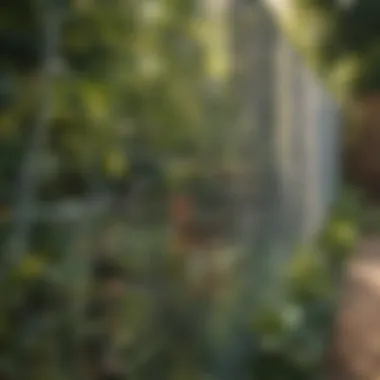
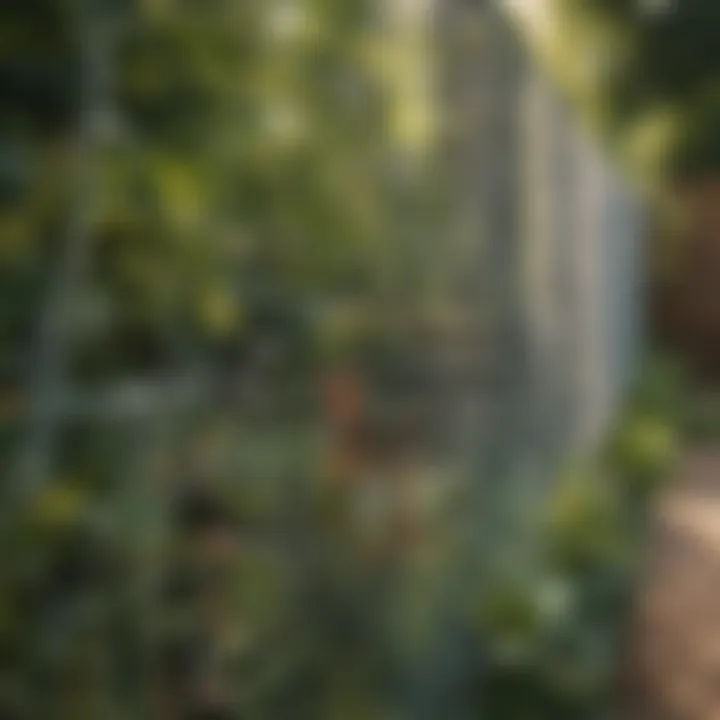
Advantages of Essential Oils:
- Eco-friendly: They don’t harm the environment or unwanted wildlife.
- Pleasant aroma: Some users even enjoy the scents.
Disadvantages of Essential Oils:
- Reapplication needed: Must be reapplied frequently, especially after rain.
- May not work for all: Effectiveness can vary based on the squirrel population.
Homemade Sprays
Homemade sprays serve as another versatile and fast approach to deter squirrels. These sprays can be crafted from common household ingredients, providing an affordable solution for anyone keen to maintain their gardens safely. A mixture of vinegar, water, and drops of chili oil can create a strong deterrent; squirrels dislike the bitterness of vinegar and the heat of chili pepper.
The main trait of homemade sprays is customization; one can adjust the ingredients based on personal preference or the specific challenges observed in their garden. Additionally, they usually consist of ingredients that are simple to find and combine. But a downside is the potential for varied potency based on ingredient concentration, which can affect their efficacy.
Advantages of Homemade Sprays:
- Cost-effective: Uses inexpensive, readily available items.
- Customizable: Adjust ratios to suit individual needs.
Disadvantages of Homemade Sprays:
- Short-lived: May need frequent application and can wash away.
- Potential odor: Some ingredients can create strong scents that may linger.
Commercial Repellents
For those who prefer a ready-made solution, commercial repellents offer a practical alternative. These products are specifically formulated to deter squirrels, often combining a variety of natural and synthetic ingredients that boast a successful track record. Commonly found in garden centers, these repellents often carry a wealth of positive reviews, stemming from their ease of use and effectiveness in deterring unwanted visitors.
When selecting a commercial repellent, it’s paramount to read the labeling to ensure it’s safe for gardens, especially if other wildlife or pets may come into contact with treated areas. Furthermore, understanding the active ingredients can inform homeowners about whether it aligns with their gardening ethics.
Ultimately, the choice between natural and commercial repellents hinges on personal preferences, environmental considerations, and the specific challenges posed by squirrels in a given space. By thoughtfully deploying these repellent strategies, homeowners can significantly cut down on squirrel invasions while fostering a harmonious garden environment.
Trapping and Relocation
When squirrels become uninvited guests in your garden, trapping and relocation can be a humane solution to address the issue. This approach does raise a few important factors to deliberate. It’s not just about catching these critters; it also requires understanding their behavior, the habitat they might be taken to, and the regulations surrounding relocation, which vary by location. By grasping these aspects, homeowners can minimize any potential harm and frustration associated with these furry intruders.
Types of Traps
There are several methods to consider when it comes to trapping squirrels effectively. Here’s a closer look at the common types available:
- Live traps: These are designed to capture squirrels without causing them harm. It’s crucial to select the right size; a trap that’s too small may not be effective, while one that’s too large might allow them to escape.
- Snap traps: Although they are often used for rodent control, it’s essential to note that these are not always recommended for squirrels, as they can work too fast and sometimes result in undue pain. If using this type, ensure it’s placed in an area where pets and children are not at risk.
- Tube traps: These traps function similarly to live traps, often providing a more spacious environment for the captured animal. They are effective in the right conditions.
Each type of trap presents its unique features and challenges. Homeowners must assess their garden environment and select an appropriate trap type based on individual needs and circumstances.
Ethics and Guidelines
Trapping squirrels should always be approached with ethics in mind. Relocating wildlife is often seen as a humane option to manage animal populations, but it is vital to follow a few guidelines:
- Research local laws: Different states, cities, or townships have regulations regarding trapping and relocating wildlife. For instance, in some areas, it's illegal to relocate wildlife beyond a certain distance from where they were captured.
- Avoid relocating too far: When relocating squirrels, aim to move them to a suitable environment that is close enough to their original habitat. This helps to prevent them from getting lost or stressed, which can happen when animals are taken too far from their known territory.
- Implement a time frame: Always check traps frequently. Leaving an animal in a trap for extended periods could lead to stress and suffering. It’s ideal to check traps at least twice a day and take immediate action once a squirrel is captured.
- Release them thoughtfully: Choose a release area that offers food and shelter, away from urbanized areas where the squirrels may struggle to adapt. Wooded or natural spaces work best, giving them the chance for a second chance in a safer environment.
- Promote preventive measures: After relocating, it’s crucial to take steps to deter further squirrel invasions. Reinforcing barriers and removing attractants can help ensure your garden remains inviting to you, rather than squirrels.
Remember, while relocation may seem like a straightforward solution, ensuring the well-being of the squirrel and the integrity of your garden should guide your decisions.
By choosing the right traps and being mindful of ethical considerations, homeowners can manage squirrel populations effectively while promoting a healthy environment in their gardens.
Creating an Unwelcoming Environment
Creating an unwelcoming environment for squirrels is an imperative strategy that can significantly reduce their presence in your garden. This approach focuses on eliminating the attracting factors that draw these critters in the first place. Not only does it involve actively managing food sources, but it also entails fostering a garden atmosphere that encourages other wildlife while dissuading squirrels. By understanding the nuances of squirrel behavior and implementing thoughtful practices, homeowners can protect their gardens more effectively. The benefits extend beyond merely keeping squirrels at bay; it helps in cultivating a healthier ecosystem overall.
Removing Food Sources
Squirrels are notorious for their resourcefulness, and one of the primary reasons they invade gardens is the availability of food. To discourage their presence, homeowners need to take a few proactive steps. Consider these strategies:
- Secure Bird Feeders: Hang bird feeders using squirrel-proof mechanisms. This can include feeders with weight-sensitive perches that close when a heavier animal is present.
- Clean Up Leftovers: After hosting outdoor gatherings or barbeques, ensure you clean up any food scraps. Even tiny remnants can tempt a squirrel.
- Compost Management: If you maintain a compost pile, be diligent about what goes into it. Avoid adding foods that attract squirrels, like fruits and nuts, and place the compost bin in a more remote area of the garden.
- Seal Garbage Bins: Ensure your trashcans are not easily accessible. Use bins with tight-fitting lids to prevent any raiding by hungry squirrels.
By eliminating food sources, you reduce the reasons squirrels might choose to invade your garden.
Maintaining a Clean Garden
A tidy garden offers far fewer attractions for squirrels than one that's overrun with debris. General cleanliness plays a pivotal role in creating an unwelcoming atmosphere. Here are some measures to consider:
- Regular Maintenance: Sweep away fallen fruits, nuts, and seeds that might attract rodents. Regularly check your garden for any natural debris that could serve as a welcome mat for squirrels.
- Proper Plant Care: Trim overgrown plants and shrubs that may harbor nests or provide shelter. When squirrels feel exposed, they are less likely to linger.
- Remove Shelter: If your garden has excessive clutter, such as piled-up wood or soil, it could provide hiding spots. Clear these areas to prevent squirrels from taking shelter.
"A clean garden isn’t just aesthetically pleasing; it’s also a less inviting space for those uninvited furry guests."
Maintaining a clean environment is more than just about looks; it's about controlling the factors that entice wildlife. With diligence in these areas, homeowners can successfully create an environment that discourages squirrels, ultimately allowing their gardens to flourish.
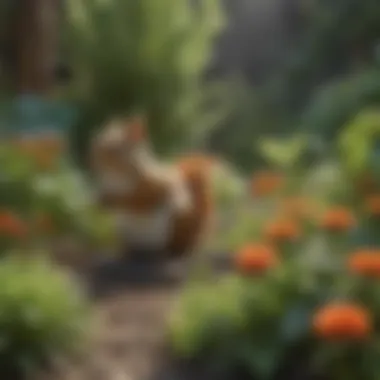
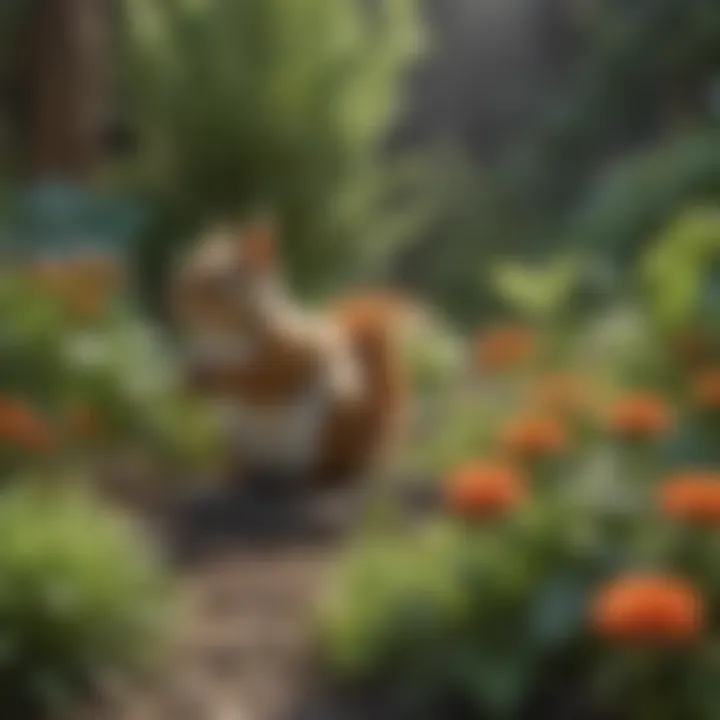
Sustainable Practices to Deter Squirrels
In our journey to understand how to keep our gardens squirrel-free, we must consider sustainable practices. Embracing a more eco-friendly approach not only helps deter these pesky critters but also contributes positively to the wider environment. Often, homeowners look for quick fixes that may work temporarily. However, these methods can leave a negative imprint on the ecosystem. Adopting sustainable practices ensures that we protect our gardens while also fostering a delicate balance with nature.
Coexisting with Wildlife
Coexisting peacefully with wildlife in urban and suburban settings is crucial for maintaining biodiversity. Instead of viewing squirrels as troublesome intruders, we can see them as part of a broader ecosystem. To coexist, it’s essential to recognize their role in controlling insect populations and dispersing seeds. Therefore, establishing a harmonious space can be beneficial for both parties.
To promote friendly relations with squirrels while safeguarding your garden:
- Educate Yourself: Understanding squirrel behavior and preferences can help homeowners design gardens that appeal less to them.
- Create Alternative Habitats: Consider leaving untouched patches or providing alternate food sources in less critical areas of your property. This could redirect them away from prized plants.
- Plant Native Species: Native plants often attract local species that can deter squirrels from introducing themselves too warmly into your garden.
"Seeing squirrels as part of your garden's ecosystem can transform the way you approach pest management. By understanding their needs, you can craft a living space that both protects plants and nurtures local wildlife."
Enhancing Garden Biodiversity
Enhancing biodiversity in your garden is not just beneficial for your plants, it also creates a balanced environment that deters squirrels. A well-balanced ecosystem can naturally control pest populations, making it less appealing for squirrels to invade. Here’s how to foster a rich garden ecosystem:
- Diverse Plant Selection: Choose a variety of plants that bloom at different times, providing continuous habitat and food for a wide range of species.
- Incorporate Companion Planting: Certain plants have companion qualities that can distract or deter squirrels. Planting herbs like rosemary or peppermint near your vegetable garden may keep them at bay while also serving culinary purposes.
- Attract Beneficial Wildlife: Installing bird feeders, toads, and ladybug hotels can attract natural predators of pests. This may change the dynamics in your garden, making it less attractive for squirrels.
- Microhabitats: Create small patches with brush piles or logs where beneficial insects, birds, or even ground squirrels might prefer to hang out, thus shifting the squirrel population away from your main garden area.
Seasonal Considerations
Understanding the changing seasons is vital for effectively deterring squirrels from your garden. Each time of year presents unique challenges and opportunities to manage these pesky rodents. As the weather shifts, so do the habits of squirrels, from their feeding preferences to their activity levels. Recognizing these seasonal changes allows homeowners to implement tailored strategies, maximizing their efforts to protect their gardens.
Spring Strategies
As the frost melts away and the days grow longer, spring signifies a newfound burst of life in gardens. Squirrels become more active during this period, looking for fresh sources of food after a long winter. It’s imperative to take preemptive measures to ensure your garden isn't turned into an all-you-can-eat buffet for these critters.
- Plant Arrangements: Consider planting in raised beds or using pots that can be easily monitored. This not only improves drainage and planting conditions but also places additional distance between potential squirrel infiltrations.
- Natural Deterrents: During spring, you can start employing natural repellents, such as a mixture of crushed red pepper and water, which can be sprayed on tender shoots. The pungent scent often keeps squirrels at bay while being harmless to plants.
- Mulching: Use mulch materials that are less appealing to squirrels—such as pine needles or gravel—around your garden’s base. This creates a less hospitable footing for them to dig and forage.
"An ounce of prevention is worth a pound of cure."
This saying holds especially true in spring when proactive steps can save you from dealing with significant damage later.
Fall Preparations
As autumn approaches, squirrels prepare for the cold months ahead by gathering and hoarding food. This time of year calls for a shift in strategy.
- Cleaning Up: Make sure to clean up fallen fruits and nuts from trees in your yard. Those delicious acorns or apples can entice squirrels, drawing them into your space.
- Review your Physical Barriers: Inspect existing fences or barriers for wear and tear. Fall is the perfect time to reinforce these deterrents before winter sets in.
- Safe Storage: Move bird feeders in close proximity to the house and make sure they are squirrel-proof, preventing access to easy food sources.
By anticipating the squirrel's behavior in fall, you set yourself up for success. Recognizing and adapting to the shifts in wildlife activity is crucial for maintaining the integrity of your garden.
Reviewing Effectiveness of Methods
When it comes to gardening, keeping squirrels at bay can feel like a full-time job. Yet, applying various strategies without gauging their effectiveness might lead you in circles, or worse, leave your garden still vulnerable. That's where reviewing the effectiveness of deterrent methods comes into play. By systematically assessing what works, you can fine-tune your approach, ensuring you strike the right balance between protecting your plants and maintaining a healthy ecosystem.
Understanding the effectiveness of the methods you've chosen isn't just about monitoring for squirrel presence. It’s also about considering how each technique aligns with your gardening goals. For instance, some approaches might deter squirrels but inadvertently affect beneficial wildlife. Evaluating method influences ensures any action taken promotes a thriving garden.
Moreover, a regular review helps you recognize changes over time. Squirrel behaviors often fluctuate with seasons, food availability, or environmental shifts. Techniques that worked in one spring might not be as effective come fall. Therefore, vigilance is key.
"Regular assessment allows gardeners to adapt strategies, turning a potentially chaotic battle against squirrels into a symphony of precision and harmony."
Assessment Techniques
Utilizing effective assessment techniques can make all the difference in mastering your garden's squirrel deterrence. Here are a few methods to keep in mind:
- Observe Activity Patterns: Keep an eye on your garden at different times of the day to spot when squirrels congregate. Document these observations to notice any patterns.
- Conduct Damage Assessments: After implementing deterrent methods, examine your garden for signs of fresh damage. Take notes on unprotected areas and squirrel activity to determine the effectiveness.
- Evaluate Deterrent Longevity: Some methods may offer short-term deterrent effects. It's crucial to evaluate how long your chosen techniques remain effective before a squirrel might return.
- Solicit Feedback: Engaging with fellow gardening enthusiasts or local gardening groups, like those on Reddit, can provide fresh perspectives and innovative methods.
Adjusting Strategies
Once you’ve assessed the performance of your methods, making adjustments is essential to enhance your garden's defenses against squirrels. Here’s how to tailor your approach for optimal results:
- Tweak Existing Techniques: If something is partially working, fine-tuning can yield better results. For example, you might have a physical barrier in place, but think about enhancing it with a natural repellent.
- Rotate Methods: Some squirrels can become familiar with specific deterrents over time. Regularly change your tactics to keep them on their toes. Mixing barriers and repellents can confuse them and dissuade them from returning.
- Expand Your Toolset: Don’t hesitate to explore new methods that might have popped up in discussions or findings from fellow gardeners. Experimenting can lead to surprisingly effective strategies that nobody expected.
- Assess Environmental Changes: As time goes on, environmental factors may shift. Perhaps nearby construction has altered the local squirrel population. Stay sharp and adjust approaches in response to any changes in squirrel behavior.
Finale
Wrapping up the strategies to keep squirrels at bay, it’s essential to grasp the core of these methods and why they matter. This article paints a detailed picture of how to protect your garden from these agile critters while aligning with ethical gardening practices. In understanding squirrel behavior, we can create tactics that are both effective and humane, ensuring that we do not harm our furry neighbors in our struggle for a flourishing garden.
Discussing the summary of key points in the previous sections shows that homeowners can opt for a combination of physical barriers, repellent techniques, and sustainable practices. These strategies not only frustrate the squirrels' attempts to invade your garden but also maintain a healthy ecosystem. The assorted measures chosen depend heavily on individual circumstances, such as the specific types of plants in your garden and the local squirrel population.
Additionally, we covered how to assess the effectiveness of the strategies employed and adjust them as needed. This flexibility is crucial, as what works one season may not be as successful the next due to changes in squirrel behavior or environmental conditions.
Finally, a garden isn't just about plants; it’s about experience, enjoyment, and nurturing life in a balanced way. By taking the time to implement these methods thoughtfully, homeowners not only gain peace of mind but also contribute positively to the local wildlife.
Summary of Key Points
- Understanding squirrel behavior is foundational for effective strategies
- Preventive measures like physical barriers can be tailored to individual gardens
- Natural and commercial repellents offer varied levels of success
- Ongoing assessment allows for strategic adjustments over time
- Sustainable practices enhance biodiversity alongside garden aesthetics
Final Thoughts
It's now up to you as homeowners and gardening enthusiasts to take these insights and craft a strategy that keeps your gardens both beautiful and squirrel-free. Happy gardening!







